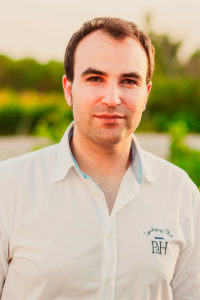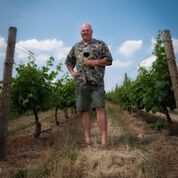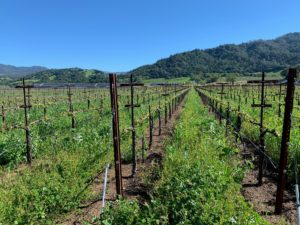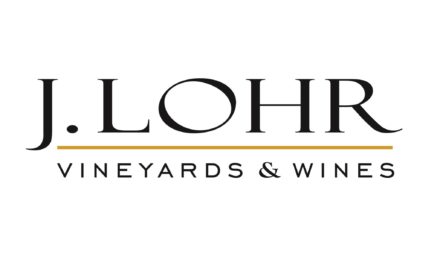Healthy soil makes for optimal crops and today, there are seemingly countless ways to monitor and test soil health, from physical samples to sap flow and moisture monitoring, aerial imagery, and beyond. Here are some of the most recent developments, as well as how technologies are being used in the field.

“Putting this analysis into winegrowers’ hands will change the industry.” —Mark Anderson, Fruition Sciences
Fruition Sciences
Precision agriculture company Fruition Sciences takes data measurements in the vineyard and puts them into an easily accessible online platform. The company started with sap flow sensors, which monitor water stress on specific plants, and has since developed other technologies to help winegrowers. Always, the plant is at the center of analysis and is used as an indicator of soil health.
The company offers several sensors, including the Dualex, which takes nitrogen readings from leaves to understand nutrient uptake from the soil. The Bacchimeter measures fruit color to understand ripening profiles and brings simple, real-time information related to phenolic maturity directly from the vineyard block. “Putting this analysis into winegrowers’ hands will change the industry,” says Mark Anderson, director of the Vintage Report at Fruition Sciences.
All information collected by these technologies is viewable on 360viti, a cloud-based platform designed to centralize and analyze data including weather, fruit composition, and aerial imagery maps. Winegrowers can use the information throughout the year to understand yield and fruit quality and, ultimately, improve growing practices.
“When you see everything in one place, it can be pretty strong,” says Anderson. “The goal is to make this a global product. There needs to be a focal point where winegrowers can connect. With 360viti, you can upload [aerial imagery], soil moisture data, spreadsheets, and more. This data augments what’s known about specific sites and puts that information into a scientific perspective.”
Spectrum Technologies
Spectrum Technologies is an international company offering a full line of measurement technology for soil compaction, soil moisture, nutrient levels, light, weather, and other factors affecting plant development.

“Soil is out of sight, out of mind—meaning we don’t always know what’s going on beneath the surface.” —Mike Thurow, Spectrum Technologies
“Soil is out of sight, out of mind—meaning we don’t always know what’s going on beneath the surface,” says Mike Thurow, president and founder of Spectrum Technologies. “It’s important to measure oxygen, pH balance, nutrients, salinity, electrical conductivity, and compaction, depending on the crop.”
Handheld meters are used for quick measurement of soil salinity, pH, and electrical conductivity (dissolved lime, calcium carbonates, and bicarbonates). Nutrient meters measure nitrates, potassium, calcium, and chlorophyll (greenness of leaves, which is especially important for crops such as hops). “The idea is that technology will help produce high-quality crops more consistently,” says Thurow, who’s seen the industry evolve tremendously since founding Spectrum 32 years ago.
“Sensors can be wireless and send data to the cloud, where users can see what’s going on in each block,” he explains. “We can put lots of sensors in the ground to assess different terrain and soil types to evaluate if those areas need different treatment due to elevation, temperatures, and soil textures.”
The company is working on developing more wireless technology to deploy devices in microclimates. “We’re leveraging our knowledge and focusing on new, more affordable technology including apps for smartphones, such as FieldScout GreenIndex [for chlorophyll and nitrogen measurement] and WatchDog for weather devices,” he says. “You can see what the temperatures are in a vineyard easily and know when to take action.”
Vintel USA, Powered By ITK
Based in France and operating globally, product development company ITK’s Vintel, developed in 2014, is new for the U.S. market. While primarily focused on irrigation, it additionally measures soil texture and a plant’s ability to pull moisture from that type of soil. It also focuses on the soil’s ability to retain water, fertilizer, and nitrogen.
“With heavy rains like we’ve had this year [in California], nutrients can wash through or run off the soil,” says Tucker Volk, technical operations manager for ITK-US. “Nitrogen is metabolized when water and temperature are sufficient, but with so much water, we need to know how much has been flushed away. If there’s not enough nitrogen and the vines grow very fast, there may be negative impacts on fruit development in both quantity and quality.” Growers can use Vintel’s data to make timely, detailed decisions regarding when to irrigate, add nutrients, and more.
“The most unique thing is that it’s model-based, not sensor-based,” says Volk. “Growers can easily model any [vineyard] block on any year, just by entering all data such as location, soil, and grape type. It uses gridded satellite predictive weather and microclimate predictors. We’re calculating the growth of the plant and crop as it relates to the water and nitrogen dynamics in the soil. There are stacks of algorithms feeding into each other.”
Growers can access the cloud-based information via an app that also includes an offline mode for entering data while in the field. They can compare the app’s virtual vineyard with their own data and make adjustments in the field accordingly. “It’s a way to conceptualize what’s going on and support decisions,” says Volk. “It’s also a way to focus on problem blocks and prioritize their management.” Growers can also use the data to display vineyard and fruit quality to potential buyers.
The company is developing a nitrogen fertilization model for next year’s growing season. It calculates how much nitrogen is present throughout the year by conducting an in-depth analysis of sand, loam, and clay content; soil temperature; and how the plant is pulling water and nitrogen from the soil. “With this model, growers will be able to drop in soil and plant analysis to understand acceptable nitrogen levels within the plant,” says Volk.

“We can define specific areas of interest for high-quality wines based on soil microbiome.” —Alberto Acedo, Biome Makers
Biome Makers
Biome Makers is a startup that focuses on soil health using DNA sequencing to identify all microbiomes in soils worldwide and their connection with soil bioactivities. It’s the first company to develop a layer of microbiome information to assess soils and recommend the best solutions for biodiversity, health, and plant nutrition. It works with more than 300 clients in 18 countries to discover microbiome profiles by location, weather, and climate change.
Its WineSeq diagnostic tool measures grape quality based on soil quality. “Microbes can influence flavors, and we’re identifying which ones have that influence,” says Alberto Acedo, Ph.D., co-founder and CSO of Biome Makers. “Microbes change according to terroir—weather, soil, and vineyard management practices all contribute,” he explains.
“Nutrition in vineyards is the key to grape quality,” Acedo continues. “Our system can learn to predict what influences pathogens and identify protective biologicals in the soil. Vineyard health depends on nearby vineyards, too. We can define specific areas of interest for high-quality wines based on soil microbiome, because vineyard characteristics are different.
“When we analyze samples, clients can see the results on an online platform. Some clients are focused on how products such as compost affect the soil. It’s important to know the composition of compost, because if biome materials such as Brettanomyces enter into the winery and are composted into the soil, this can introduce bad yeast into the soil.”
The company is also measuring the effect of biological sprays to stimulate roots. “We can use the information to recommend soil improvement products, especially biologicals and probiotics—that’s the future,” says Acedo. “Growers have access to all sorts of images, sensors, and data. We’re providing a new level of information.”

“You can be so specific, it’s amazing. With precision farming, there’s no waste.” —Bill Heritage, William Heritage Winery
Digging deeper
Bill Heritage, proprietor of William Heritage Winery in New Jersey, is a fifth-generation farmer of peaches and apples. In 1999, he began farming winegrapes. His 150-acre farm is now planted to 50 vineyard acres and 20 stone fruit acres.
In the beginning, he planted one acre each of chardonnay and cabernet franc. “It grew like weeds,” he says. “We planted more, but things started to run out of gas and we had to amend the soil by adding lime. It’s all about the dirt.” Heritage investigated further by digging a four-by-four-by-six foot hole and found, “There’s a compaction two feet down from so many years of farming. It’s like concrete. The vine roots can’t penetrate it to reach the water and nutrients below,” he says. “Now we’re using composting and cover crops, which keep the ground at a peak level.”
Heritage also uses data collected from Spectrum Technologies’ in-ground weather stations and water sensors to better manage the land. “It helps us predict things and be more efficient. There are different microclimates out there and we want to be precise,” he says. “There are apps to help make decisions. You can plug in data regarding soil type, pH level, and more, and it can help with soil amendment decisions. You can be so specific, it’s amazing. With precision farming, there’s no waste.
“Soil health is something we used to take for granted,” says Heritage, who’s employed similar practices in his fruit orchards and has seen increased vigor over the past year. “We didn’t know what was going on below our feet. But once you look deeper, it’s the starting point for everything. We’re learning and seeing results—and the fruit quality is great.”
Conserving resources
Brad Petersen is vineyard manager for Silver Oak Cellars and Twomey Cellars in Sonoma County, Calif. He and his team have been managing vineyard acreage since 1999, and while the soil tests they use haven’t changed much, the time taken and practices used to keep soils healthy has.

Silver Oak Cellars’ Alexander Valley Vineyard
In 2012, Silver Oak Cellars purchased a 115-acre property in Alexander Valley (Sonoma County) that was originally planted with cabernet sauvignon, sangiovese, petite sirah, and zinfandel. “We farmed that for two years, then began replanting exclusively with cabernet sauvignon,” he says. The property now has 75 acres planted to that variety.
“We had enough lead time to use resistivity mapping,” says Petersen. “It’s like an MRI; it uses magnetic waves to read variations in soil type, producing a map of the property. We used it to create a block layout and amend with compost and minerals prior to planting, as well as matching irrigation blocks to soil type.”
Petersen’s team uses Fruition Sciences tools to help with irrigation scheduling, tracking vine growth, and monitoring nitrogen levels in leaves. It also employs canopy temperature sensors to check variances in microclimates within blocks. Sap flow monitors are used in multiple blocks to time irrigation. “The sap flow monitors help us control the amount of water used without causing stress or too much vigor,” he says. The team also plants cover crops each fall to help with soil nutrition and erosion control, and is closely monitoring soil moisture and its effect on nitrogen levels.
Petersen sees today’s technology tools as a way to conserve resources. “It’s more complicated than in the past because there’s more to look at. Sometimes it doesn’t all correlate and you have to figure out what that means, but the result is knowing exactly what to do, where, and when.
“We work hard to find sites that produce high-quality grapes. And we do everything we can to keep the soil healthy and sustainable for generations to come,” says Petersen.
Using today’s tools and technologies, growers can ensure sustainable soil health right now and far into the future.













